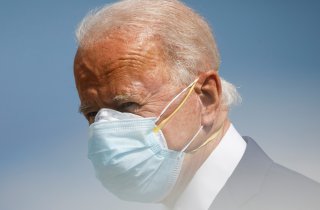Triple-Masking: The Ultimate Protection From Coronavirus?
Wearing three masks likely creates a more effective barrier for outgoing and incoming particles, but keep in mind that it will also make it more difficult to breathe.
The U.S. Centers for Disease Control and Prevention already has confirmed that double-masking, or the wearing of two face masks at once, can provide extremely high levels of protection against spreading or contracting the novel coronavirus.
The agency’s researchers said they explored the overall effectiveness of various masking approaches via laboratory experiments, which found that when an individual wears just one mask, either surgical or cloth, it blocked about 40 percent of the viral particles. However, wearing a cloth mask on top of a surgical mask was able to block about 80 percent of particles, while 95 percent was blocked when both individuals wore two masks, the researchers added.
With this in mind, would triple-masking offer even better protection?
Yes, theoretically it should, as it will provide more “obstacles” for viral particles to get through. But experts have acknowledged that there are indeed pitfalls when one tries to pile on masks.
For example, you may be more tempted to fiddle with the additional masks and that could create issues if you’re in a space where there are many people potentially spreading virus-laden droplets. You could also touch a contaminated surface, then bring the viral particles to your mask.
Wearing three masks likely creates a more effective barrier for outgoing and incoming particles, but keep in mind that it will also make it more difficult to breathe.
Dr. Dave Hnida, a medical editor at KCNC-TV in Denver, recently noted that “two masks may actually equal the protection you would get from N95 masks, which is considered the best mask there is short of a complete respirator-type unit.”
But according to Dr. Kim Mi-na, a professor who specializes in clinical microbiology and nosocomial infections at Asan Medical Center in Seoul, N95 and the South Korean equivalent KF94 masks “are not comfortable to wear for a long time” because “KF94 or N95 masks make it difficult to breathe . . . and the filter is vulnerable to moisture and should not be used for a long time. It is difficult for people infected with the disease to even use them.”
If this is the case, then three masks will likely be overkill for the majority of the population and should definitely not be used by those suffering from any respiratory issues.
Kim added that masks need to be worn properly as well, or they will be less effective in protecting the wearer.
“KF94 or N95 masks have an excellent function of capturing nasal mucus, but they are not effective if the face and mask edges are not adhered to each other,” she wrote in an op-ed published in the Journal of Korean Medical Science.
A recent CDC study discovered that a tighter fit can markedly improve the overall effectiveness of masks. One particular way to improve the fit of medical masks is to make sure they are “knotted and tucked”—which can be achieved “by bringing together the corners and earloops on each side, knotting the ear loops together where they attach to the mask, and then tucking in and flattening the resulting extra mask material to minimize the side gaps,” the agency wrote.
Ethen Kim Lieser is a Minneapolis-based Science and Tech Editor who has held posts at Google, The Korea Herald, Lincoln Journal Star, AsianWeek, and Arirang TV. Follow or contact him on LinkedIn.
Image: Reuters

